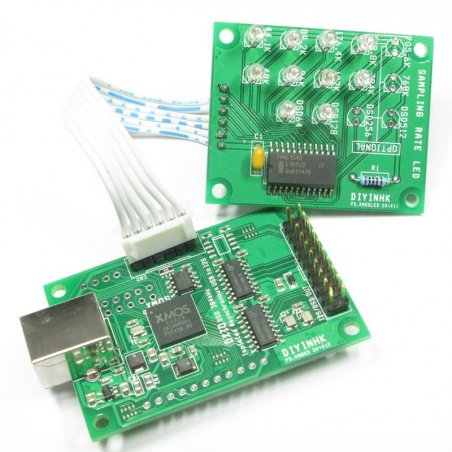- -$20.00
- Out-of-Stock




DXIO PRO2 is using NDK NZ2520SD Ultra low phase noise oscillator
Isolated XMOS DSD DXD 384kHz high-quality USB to I2S/DSD PCB with ultralow noise 6.5uV regulator and sampling rate LED indicator PCB(all smd are soldered, thru hole component are not soldered)
This is the best USB to Isolated I2S/DSD PCB for audiophile Diyer to enjoy, with the audio oscilaltor on the clean isolated side, it take the performance to the other world.
Features:
1) Newest XMOS chip and uses 48MHz oscillator to asynchronous reclock usb audio data to I2S line, old XMOS uses only 13Mhz oscillator, over 4x better jitter rejection theoretically.
2) Audio oscillators 22.5792Mhz and 24.576Mhz are located on the clean isolated side for highest performance.
3) 6.5uVrms Ultralow noise linear power regulator (use of decade old LM317/1117 regulator is kidding for audiophile)
4) Solid ground plane (a must for high speed digital circuit)
5) No Via in active circuit (via inductance always create jitter problem)
6) NDK NZ2520SD Ultralow phase noise oscillator are sourced from Japan directly (guarantee no fake product from China)
According to the official datasheet, the phase noise is much better than the famous crystek 957 under 25khz(human listenable range)
For easier comparsion(lower is better), we overlay the two phase noise graph at the same scale, under 25khz(human listenable range) nz2520sd(red line) is better, over 25khz(human unlistenable range) crystek 957 is better.
7) Gold plated USB connector (Molex, FCI, or other depends on stock)
8) Compact size 60mm x 40mm
No drivers needed for MAC OS version 10.6.4 and above
No drivers installation required for Linux with UAC2 compliant kernel
ASIO/KS/WASAPI/Direct Sound drivers for Windows XP to 8 (32 and 64 bit)
Fully featured Thesycon driver package (without 30 min. periodic beeps)
Windows 7/8/Vista/XP Driver is available to download from our website
http://www.diyinhk.com/shop/9-driverdatasheetmanual
*USB2.0 is a must for 384kHz operation
*Use a fresh install of windows and a dedicated USB port always avoid problem and run stable
*The length of I2S connection to your DAC chip should be as short as possible for best result and below 10cm is recommended
Please check your DAC should support the following I2S signal specification to decode each sampling rate:
| DATA | LRCK | BCLK | MCLK |
| 16/24bit | 44.1kHz | 2.8224Mhz | 22.5792Mhz |
| 16/24bit | 48kHz | 3.072Mhz | 24.576Mhz |
| 16/24bit | 88.2kHz | 5.6448Mhz | 22.5792Mhz |
| 16/24bit | 96kHz | 6.144Mhz | 24.576Mhz |
| 16/24bit | 176.4kHz | 11.2896Mhz | 22.5792Mhz |
| 16/24bit | 192kHz | 12.288Mhz | 24.576Mhz |
| 16/24bit | 352.8kHz | 22.5792Mhz | 22.5792Mhz |
| 16/24bit | 384kHz | 24.576Mhz | 24.576Mhz |
DSD playback steps using foobar2000 in Microsoft Windows:
1. Download and install the latest version of Foobar2000 from the official website
http://www.foobar2000.org/download
2. Download and install the official ASIO output plug-in for Foobar2000
http://www.foobar2000.org/components/view/foo_out_asio
3. Download the latest version of Super Audio CD Decoder plug-in for Foobar2000
http://sourceforge.net/projects/sacddecoder/files/foo_input_sacd/
3a) unzip and double click to install ASIOProxyInstall-x.x.x.x.exe
3b) Foobar > Files > Perferences > Components > Install > foo_input_sacd.fb2k-component
4. Configure the output device: Foobar > Files > Perferences > Playback > Output > Device (ASIO: foo_dsd_asio)
5. Configure the ASIO output: Foobar > Files > Perferences > Playback > Output > ASIO > foo_dsd_asio(double click)
5a) ASIO Driver: DIYINHK DXIO USB Audio
5b) DSD Playback Method: DoP Marker 0x05/0xFA
6. Foobar > Files > Perferences > Tools > SACD > ASIO Driver Mode: DSD
More detail: http://www.google.com/search?q=foobar+dsd
User guide:
1) If you do not play DSD from the computer, the PCB will not output DSD signal. It's the same as our old PCB without DSD
2) The isolated clean side is powered by external regulated 3.3V(>50mA) from the 20pin header labelled 3.3vINx2 and GND, it is usually connected to the same 3.3v digital power the DAC is using(warning: over-voltage or reverse-voltage can damage the xmos chip immediately, double check before power on). Xmos will not start until it can detect the 3.3V on the isolated side is present.
3) For DSD playback, LRCK= DSD D1(Left channel), DATA= DSD D2(right channel), BCK = DSD Bit Clock
4) Pins labeled (SDA SCL RST MUTE) on CN1 are reserved for used with DAC firmware customization(i.e. software control different DAC with different firmware), it should be left unconnect. CN1 Pin labelled DSDon is isolated, it is high when playing DSD and low when playing PCM.
5) For DSD playback, windows volume mixer must be set to full volume.
6) Different DAC chip needs different software command to switch between DSD and PCM mode. Please read the corresponding DAC datasheet for detail.
This item is in limited stock, maximum two per buyer. Please contact us if you want to buy more than two, thanks.
Data sheet
You might also like